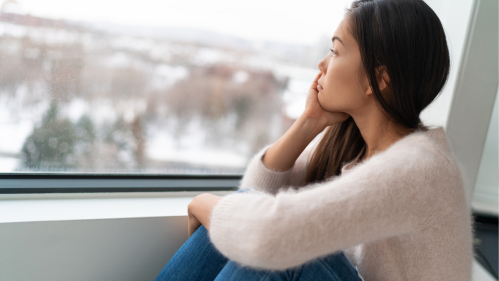Tips for Fighting the Winter Blues

Seasonal affective disorder (SAD) often hits hardest right around the end of daylight saving time, but its effects can be minimized, says Rutgers psychologist
As the clocks fall back for the end of daylight saving time and the season moves closer to winter, many people are often struck with seasonal affective disorder (SAD), better known as seasonal depression. The physical and mental effects can make getting through the winter months difficult, but having the right tools can make all the difference, says Stephanie Marcello, chief psychologist at Rutgers University Behavioral Health Care. Marcello talked to Rutgers Today about the condition and what you can do to help yourself feel better.
What is SAD and what are some common symptoms?
When daylight decreases and temperature drops, some people may experience symptoms that go beyond the common “winter blues” and resemble more of a seasonal depression. Seasonal Affective Disorder (SAD) is a type of depression that follows a seasonal pattern, most commonly occurring in the winter, though some people experience it in the summer, known as Summer Seasonal Affective Disorder (SSAD). It is a type of depression that occurs seasonally, typically in the winter months, and subsides during the rest of the year. Symptoms of SAD are the same as those seen in depression, varying in severity and intensity. Some symptoms include fatigue, feeling sad most of the day for most days, trouble with sleep including excessive sleeping, eating too much or too little, weight gain or loss, feeling hopeless, and losing interest in friends and activities the person typically enjoyed. These symptoms can interfere with personal relationships and, for some, be quite disabling. Sometimes people can experience thoughts of suicide. An individual might notice they feel very different than how you feel in other seasons. Professionals differentiate between depression and SAD by evaluating if you have remission of these symptoms in the spring and summer months. If you have had these symptoms for more than two winters, you might want to be evaluated for SAD.
Could spending more time outdoors during the day help reduce the symptoms of SAD?
Lack of sun exposure is part of what causes SAD, so getting as much sunlight as possible may lessen symptoms. Whenever possible, try to get outside during daylight hours and expose yourself to sun. Sunlight, even in small doses, can help boost serotonin and improve your mood. Taking a short walk or even sitting near natural sunlight in your home and workplace can be helpful.
There are products on the market, like bright light therapy, that claim to alleviate SAD symptoms. Are these worth the money?
Bright light therapy (LT) has a long history of supportive research. Light therapy works through alterations in the circadian rhythms. These bright lights stimulate cells in the retina that connect to the hypothalamus, a part of the brain that helps control circadian rhythms. Some research shows it being effective for up to 85 percent of individuals. We recommend starting light therapy in the fall before the onset of the symptoms.
Cognitive behavioral therapy for SAD has received support in the literature also and includes behavioral activation aimed at decreasing avoidance and increasing engagement in pleasurable activities during the winter and therapy aimed at restructuring depressive thoughts.
What are simple ways to fight the effects of SAD?
Get outside, reach out to friends and family, join a support group, eat the right diet (symptoms can make you crave sugary food and simple carbohydrates), eat foods rich in omega-3 fats, learn relaxation techniques, do things you love and enjoy, even when you don’t feel like it. It is very important to talk to friends and family if you are experiencing any of these symptoms and seek professional help when needed.
Besides light therapy what are some other ways to motivate ourselves or trick the brain into overcoming these symptoms?
Antidepressants, particularly SSRI’s, can be helpful in reducing symptoms, but it’s important to talk to your doctor to determine if they are right for you. Engaging in enjoyable or meaningful activities, even when energy is low, can “trick” the brain into releasing mood-boosting chemicals like dopamine and serotonin. Mind-body practices such as yoga, mindfulness, and meditation also reduce stress and improve emotional balance. Getting outside, staying active, maintaining good sleep, and eating nutrient-rich foods can also help regulate mood. Please don’t suffer in silence, reach out for help. SAD has very effective treatments available.


